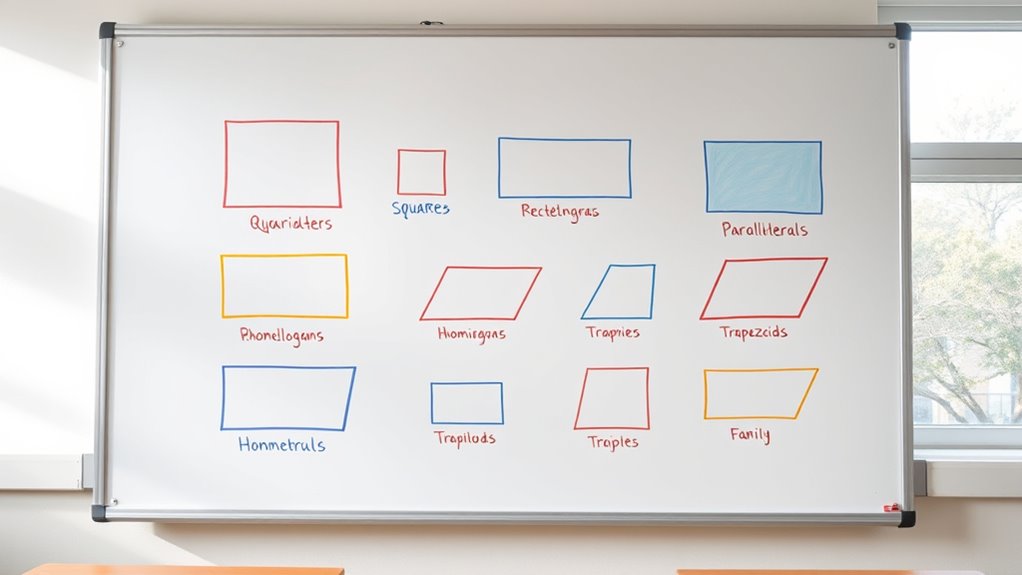Quadrilaterals are four-sided shapes with angles that always add up to 360°. You’ll find different types based on side lengths and angles, like squares with four right angles and equal sides, rectangles with equal opposite sides and right angles, parallelograms with opposite angles and sides, trapezoids with at least one pair of parallel sides, and rhombuses with four equal sides. If you stick around, you’ll discover the key features that help identify each shape and how they relate.
Key Takeaways
- Quadrilaterals are four-sided polygons with varying angle and side properties classified into types like squares, rectangles, trapezoids, and more.
- The sum of interior angles in any quadrilateral always equals 360°, aiding in shape identification.
- Squares have four equal sides and right angles, while trapezoids have at least one pair of parallel sides.
- Parallelograms feature opposite sides equal and parallel, with opposite angles equal and supplementary angles adjacent.
- Recognizing side lengths, angles, and parallel sides helps differentiate among quadrilateral types effectively.

Have you ever wondered what makes a quadrilateral different from other shapes? It all comes down to their defining features and how they’re classified. A quadrilateral is a four-sided polygon, but not all four-sided shapes are the same. To understand what sets them apart, you need to look at their angle properties and classification criteria. These elements help you distinguish between squares, rectangles, trapezoids, and other four-sided figures.
First, let’s focus on angle properties. In a quadrilateral, the sum of all interior angles always equals 360 degrees. This is a fundamental rule that applies to every shape in this category. Some quadrilaterals have special angle properties; for example, in a rectangle, all four angles are right angles, each measuring 90 degrees. This makes rectangles a special case within the broader group. Conversely, in a parallelogram, the opposite angles are equal, and adjacent angles are supplementary, meaning they add up to 180 degrees. Recognizing these angle properties helps you classify the shape correctly. For instance, if you find a four-sided figure with two pairs of equal angles, it might be a parallelogram. If all angles are right angles, it’s a rectangle, and if all sides are equal with four right angles, it’s a square.
Next, classification criteria are what you use to sort quadrilaterals into different types. These criteria include side lengths, angles, and parallel sides. For example, if all sides are equal and angles are right angles, you’re dealing with a square. If only opposite sides are equal and parallel, and angles aren’t necessarily right angles, it could be a parallelogram. Trapezoids, on the other hand, are defined by having at least one pair of parallel sides. The classification criteria also help you identify special types, like rhombuses, which have four equal sides but don’t necessarily have right angles. By examining the side lengths and angles, you can determine the specific type of quadrilateral you’re dealing with.
Understanding these fundamental concepts allows you to quickly recognize and categorize any quadrilateral you encounter. Whether it’s a kite, a trapezoid, or a square, knowing the angle properties and classification criteria makes it easier to analyze their shapes and understand their relationships. Additionally, understanding the angle sum property of 360 degrees can aid in solving geometric problems involving quadrilaterals. This knowledge isn’t just academic; it helps you solve real-world problems in design, architecture, and even in puzzles or games. By paying attention to these details, you gain a clearer picture of what makes each quadrilateral unique and how they fit into the larger world of geometry.
Frequently Asked Questions
How Do You Classify Irregular Quadrilaterals?
To classify irregular quadrilaterals, you focus on their unique properties, such as side lengths and angles, since they don’t fit standard shapes. Use classification methods like checking if sides are equal, if angles are right, or if opposite sides are parallel. By analyzing these irregular shape properties, you can determine whether the quadrilateral is a kite, dart, or another type, even without regular symmetry or equal sides.
What Are the Real-World Applications of Quadrilaterals?
You use quadrilaterals in architectural design and engineering structures to create stable, functional buildings and bridges. They help you design various elements like windows, doors, and supports, ensuring strength and aesthetic appeal. By understanding quadrilateral properties, you can optimize materials, improve load distribution, and enhance structural integrity. These shapes are essential tools in your work, enabling efficient, durable constructions that meet safety standards and architectural goals.
How Do Angle Sums Differ in Concave Quadrilaterals?
In concave quadrilaterals, the angle sum variations occur because some angles are concave, measuring more than 180 degrees, which affects the overall sum. Unlike convex quadrilaterals where the total always equals 360 degrees, concave ones have interior angles adding up to 360 degrees, but with some angles exceeding 180 degrees. This unique property influences the shape’s geometry and how you interpret the angles’ relationships within the figure.
Can a Quadrilateral Be Both Convex and Concave?
No, a quadrilateral can’t be both convex and concave at the same time. Types of quadrilaterals are classified by their properties of convexity; a convex quadrilateral has all interior angles less than 180°, while a concave one has at least one angle greater than 180°. If a shape exhibits properties of both, it would be geometrically impossible. Focus on the properties of convexity to identify the type of quadrilateral you’re dealing with.
How Are Diagonals Used to Differentiate Quadrilaterals?
Imagine you’re examining a rhombus; you notice its diagonals intersect at right angles, which helps you identify it. Diagonals reveal key properties like intersection points and lengths that distinguish quadrilaterals. For example, in rectangles, diagonals are equal and bisect each other, while in parallelograms, diagonals bisect each other but aren’t necessarily equal. These diagonal intersection properties and lengths are essential clues for identification.
Conclusion
Now that you’ve explored the world of quadrilaterals, picture yourself walking along a path lined with squares, rectangles, and trapezoids, each shape whispering its unique story. These four-sided figures are like different faces of a familiar family, each with its own personality. With this knowledge, you can confidently identify and appreciate their subtle differences. So, next time you see a shape, imagine its hidden angles and sides—ready to reveal the secrets of geometry all around you.









